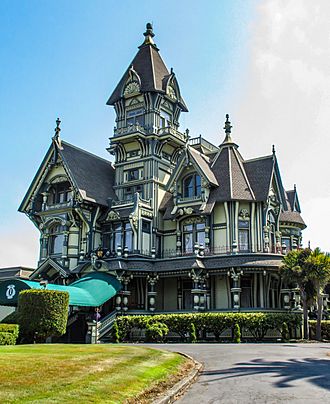Carson Mansion facts for kids
Quick facts for kids Carson Mansion |
|
|---|---|
 |
|
| General information | |
| Architectural style | Queen Anne |
| Town or city | 143 M Street Eureka, California |
| Country | United States |
| Coordinates | 40°48′20″N 124°09′31″W / 40.80562°N 124.15848°W |
| Construction started | 1884 |
| Completed | 1886 |
| Cost | $80,000 (equivalent to $2,605,630 in 2022) |
| Client | William Carson |
| Owner | Ingomar Club |
| Technical details | |
| Structural system | Concrete foundation; Douglas Fir frame; Redwood exterior |
| Size | In excess of 16,200 sq ft (1,510 m2) on 3 floors (excluding basement) plus 103-foot (31 m) tower; 18 rooms |
| Design and construction | |
| Architect | Samuel Newsom and Joseph Cather Newsom |
| Engineer | W. H. Mills (construction supervisor) |
The Carson Mansion is a huge, beautiful Victorian house. It was built between 1884 and 1886. You can find it in Old Town, Eureka, California.
Many people think it's one of the best examples of Queen Anne style architecture in the United States. Some even call it "the most grand Victorian home in America." It's a very famous house, often written about and photographed.
Contents
What is the Carson Mansion?
The Carson Mansion was once the home of William Carson. He was a very important lumber businessman in Northern California. Since 1950, the mansion has been a private club.
This means the house and its gardens are not open to the public. It is owned and used by the Ingomar Club.
Who was William Carson?
William Coleman Carson was born in 1825 in New Brunswick, Canada. He came to San Francisco in 1849 with other woodsmen. They were looking for gold.
Later, they joined the gold rush in the Trinity Mountains. They also helped supply logs for a small sawmill. In 1850, Carson and Jerry Whitmore cut down the first tree for business in Humboldt Bay.
Carson decided to stay in the lumber business. In 1854, he sent the first loads of redwood timber to San Francisco. Before this, only fir and spruce trees were used for lumber.
How did the Carson Lumber Company grow?
In 1863, Carson started the Dolbeer and Carson Lumber Company with John Dolbeer. Eighteen years later, in 1881, John Dolbeer invented something amazing. It was called the Steam Donkey Engine.
This machine changed how logs were moved. It made it much easier to get logs from hard-to-reach places. Around the same time, Carson also helped start the Eel River and Eureka Railroad.
Before building his mansion, Carson said he would build it just for himself. In 1884, his company was producing a huge amount of lumber every year. They also owned ships to move lumber all over the world.
This meant Carson had plenty of money and materials for his grand home. In 1950, the Pacific Lumber Company bought Carson's company. The Carson family then left the area.
What is the Ingomar Club?
Local business leaders bought the mansion in 1950. They paid $35,000 for it. It became the home of the Ingomar Club.
The club was named after Carson's Ingomar Theater. That theater was named after Carson's favorite play, Ingomar the Barbarian.
What architectural styles does the Carson Mansion have?
The Carson Mansion is a mix of many different Victorian styles. These include Eastlake, Italianate, Queen Anne, and Stick. The Queen Anne style is the main one you see.
One expert called the house "a baronial castle in Redwood." They also said its grand look comes from its playful details. The house has always been well-kept. It looks almost the same as when it was built.
In 1964, the house was added to the Historic American Buildings Survey. This is the only official historical listing for the house. The Ingomar Club has chosen not to apply for National Register of Historic Places status.
Who designed the Carson Mansion?
The architects were Samuel Newsom and Joseph Cather Newsom. They were a father and son team from San Francisco. Carson hired them to design the house by 1883.
They designed many buildings in California. Some of their other famous works include the Napa Valley Opera House and the San Dimas Hotel.
They also designed another Queen Anne style house in Eureka. It was called "The Pink Lady." William Carson gave it to his son Milton as a wedding gift in 1889. This house was later restored in 1964. It was the first historic building in Eureka to be restored.
Another Queen Anne style design by the Newsoms was the 1885 Murphy House in San Francisco. It was destroyed in the 1906 San Francisco earthquake. A replica of it was built in Eureka in 1982. It is now the Carter House Inn.
See also
 In Spanish: Mansión Carson para niños
In Spanish: Mansión Carson para niños


